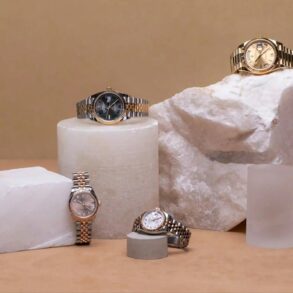In an era dominated by speculative indexes and cryptocurrency fervour, the world of investment is witnessing a paradigm shift.
Traditional investment avenues are facing competition from an unexpected quarter: the realm of high-end fashion. Luxury goods, from limited-edition watches to vintage handbags, are emerging as formidable alternatives within our financial landscape, and investors are redefining what it means to dress for financial success. The allure of luxury fashion lies not just in owning these prestigious items but in their incredible potential to appreciate significantly over time.
In this exploration of the intersection between fashion and finance, I examine the investment value of luxury fashion merchandise, assessing its viability and discerning its prospects.
The enigma of investing in rare, limited-edition, vintage, and designer fashion items transcends the transient nature of trends and has proven to be a lucrative endeavour. The luxury market has steadily grown at an average of 10 percent per year since the 1980s, outpacing the rate of global economic growth.
Luxury fashion items, such as watches, jewellery, and handbags, offer low correlation with traditional assets, reducing portfolio volatility and counterbalancing market conditions. J.P. Morgan’s research shows a 7 percent increase in the luxury goods market in Q4 2022, despite price increases. This resilience fortifies luxury brands and rewards investors who anticipated potential. Appreciating luxury goods can act as a hedge against inflation and offer stability during economic decline, although they may not outperform the general stock market.
Limited editions, rare materials, and iconic designs contribute to the scarcity and exclusivity of luxury fashion items, factors that can positively impact their long-term value. Scarcity is crucial in the luxury fashion business model. “A rule of thumb in the current market: If a watch is available for anyone off the street to purchase out of the display case in an authorised dealer, it’s typically not an investment-worthy piece,” says Rob Petrozzo, the co-founder of Rally, a liquid financial marketplace for buying and selling stocks.
In 2020, vintage watches, particularly Rolexes, and luxury handbags outperformed other assets. Rolex watches saw a 33 percent increase in annual returns in 2021, while Chanel handbags saw a 24.5 percent increase due to the scarcity of Lagerfeld-designed bags. Hermès Birkin bags, while displaying higher volatility, have a superior risk-reward ratio than Chanel bags. Both Rolex watches and Chanel handbags have information ratios of 200 percent or higher.
Although Chanel’s price increases have been the source of much debate and criticism, buyers are not deterred as demand remains strong, driving the company to a historic revenue milestone of $15 billion in 2021. The iconic Chanel Classic Flap bag now commands $8200, a roaring 613 percent increase from its $1150 price tag in 1990. Additionally, vintage Birkins can be sold for up to six figures at auctions and are cited to have higher investment returns than gold.
Branded jewellery and watches are enjoying continued success, driven by their historical and cultural significance, enduring appeal, and especially consumer confidence, positioning them as sought-after investment options. Brand names such as Van Cleef and Arpels, Cartier, and Bulgari are placed at the centre of the luxury jewellery market conversation, with a particular spotlight on their vintage pieces. McKinsey predicts a compound annual growth rate of 8 percent to 12 percent for branded jewellery from 2019 to 2025. High-quality stones and gems, especially diamonds, continue to see steady growth in prices.
In the watch industry, luxury and ultra-luxury brands are asserting dominance and leading the way, utilising brand heritage, narrative, and innovation to capture consumer interest. The pre-owned watch market is surging, with Christie’s recording a record-breaking year in online watch sales, with totals of $5,592,000, $5,878,000, and $7 million in October, November, and December 2021. The Knight Frank Luxury Investment Index reveals that watches have experienced a growth rate of 8 percent in 12 months, with a remarkable 76 percent increase over a period of ten years. A Patek Philippe watch, originally priced at less than $20,000 in the 1980s, can now sell for over $400,000, more than doubling its retail value. You can insure Rolex, but you can’t insure cash. The longevity and durability of well-crafted luxury items, especially watches, allow them to last for generations with proper care, making them durable investments that retain value over time.
Focusing on reputable luxury brands like Hermès, Chanel, Tiffany & Co., and Rolex is crucial for investment value both now and in the future. Rolex, a symbol of enduring quality, has shown remarkable appreciation potential in the luxury watch market. Lindsay Sakraida, director of content marketing at DealNews, emphasises the importance of timeless brands, as they connote quality both now and in the future, making them a secure choice for investment pieces.
When selecting an investment piece, focus on its longevity and craftsmanship. Classic, iconic bags that have never fallen out of fashion offer significant returns. Avoid trendy “It” bags that lack appeal. Consider brand, price, condition, rarity, aesthetics, and market size when evaluating luxury goods. Unique colours or exquisite leathers can further enhance value. Instead, choose classic, iconic bags that have never fallen out of fashion.
Traditional investments, such as stocks, bonds, and cash, are well-established as the bedrock of investment portfolios. They offer stability while providing liquidity and ease of trading. However, they are not without weaknesses, especially in the short term, where market volatility can impact the balance of a portfolio. Alternative investments, including hedge funds, real estate, and collectables like art, antiques, wine, and luxury fashion items, present unique opportunities. Investors often turn to alternatives for their potential economic value not found in standard portfolios, controlled risk, high returns, and diversification benefits.
Luxury goods come with inherent limitations and risks, including illiquidity, difficulty in reselling, and potential loss or damage. While they can protect against inflation, they may not surpass the performance of the general stock market. Luxury items are illiquid assets, and selling them can be time-consuming and costly. Knight Frank reports that the illiquidity of luxury items necessitates strategic planning.
Market trends and consumer preferences can influence the value of luxury fashion items, with oversaturation negatively impacting prices and loss of exclusivity. Economic factors like recessions can also affect supply and demand, forcing owners to sell, increasing supply and decreasing prices. Additionally, counterfeits in the secondary market pose a significant risk, prompting investors to conduct thorough research before making impulse luxury purchases.
High-end watches require regular servicing to maintain their performance and value, including cleaning, oiling, replacing worn parts, and repairing damage. These expenses can accumulate quickly, making condition and maintenance costs crucial for investment decisions. Market experts like Adam Golden emphasise the importance of maintaining the originality of luxury items, as restoration or damage can lead to significant depreciation of value. Investors seeking high returns must also be able to take the risk associated with high levels of uncertainty, as high levels of uncertainty can indicate higher returns, while lower levels can indicate lower returns.
Luxury goods are a unique and compelling asset in wealth accumulation, offering a blend of aesthetic pleasure and financial promise. However, investors must navigate risks like illiquidity, market trends, and the condition of these unique assets. Comprehensive research, due diligence, and understanding of the luxury market dynamics are crucial for success in integrating these assets into a well-rounded investment portfolio. Scarcity, brand reputation, and provenance determine the profitability of these luxury items. As financial portfolios undergo sartorial makeovers, the question lingers: are stocks, bonds, and ETFs truly obsolete?
Ritsean Jemide is a Fashion Designer & Creator.
This post was originally published on this site be sure to check out more of their content.







